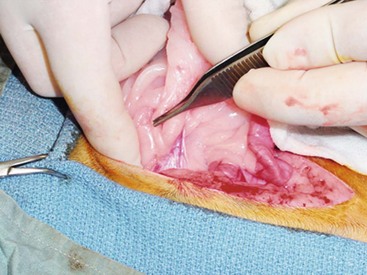Chapter 218 Because remnant ovarian tissue is found in typical anatomic locations and is not considered ectopic tissue in dogs, surgical error is suspected as the cause of ORS. In dogs, location of remnant ovarian tissue is found more frequently in the region of the right ovarian pedicle, probably because the more cranial position of the right ovary and difficulty in exposure and removal of the right ovary during OHE. However, Miller (1995) found remnant ovarian tissue to be distributed equally between the right and left side. Differences between dogs and cats provide further support for surgical error as the cause of ORS and may account for more dogs than cats being affected. Dogs have more adipose tissue surrounding the ovaries that can obscure exposure. The suspensory ligament of the ovary in dogs is more difficult to rupture to achieve adequate exposure, compared with cats. In addition, dogs typically have a deeper abdominal cavity, which makes it more challenging to exteriorize each ovary (Figure 218-1). Figure 218-1 Canine ovarian tissue in situ. Dogs typically have a deeper abdominal cavity, which makes it more challenging to exteriorize each ovary during OHE. (Photo courtesy Dr. Robert J. McCarthy, Tufts Cummings School of Veterinary Medicine, North Grafton, MA.)
Ovarian Remnant Syndrome in Small Animals
Potential Causes for Ovarian Remnant Syndrome

![]()
Stay updated, free articles. Join our Telegram channel

Full access? Get Clinical Tree


